(一)NIO 基础
non-blocking io:非阻塞 IO
1、三大组件
1.1、Channel & Buffer
Java NIO系统的核心在于:通道(Channel)和缓冲(Buffer)。通道表示打开到 IO 设备(例如:文件、套接字)的连接。若需要使用 NIO 系统,需要获取用于连接 IO 设备的通道以及用于容纳数据的缓冲区。然后操作缓冲区,对数据进行处理。简而言之,通道负责传输,缓冲区负责存储
常见的 Channel 有以下四种,其中 FileChannel 主要用于文件传输,其余三种用于网络通信:
- FileChannel
- DatagramChannel
- SocketChannel
- ServerSocketChannel
Buffer 有以下几种,其中使用较多的是 ByteBuffer:
- ByteBuffer
- MappedByteBuffer
- DirectByteBuffer
- HeapByteBuffer
- ShortBuffer
- IntBuffer
- LongBuffer
- FloatBuffer
- DoubleBuffer
- CharBuffer
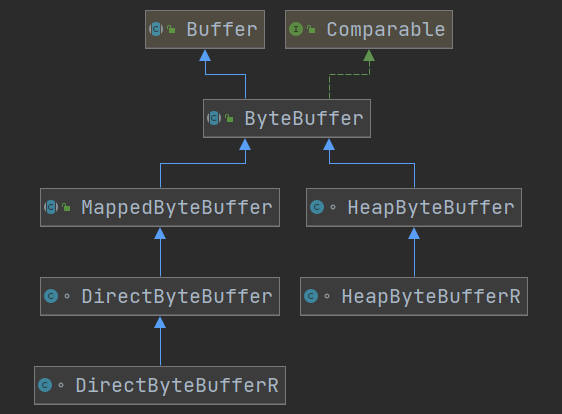
1.2、Selector
在使用 Selector 之前,处理 socket 连接有以下两种方法:
1、使用多线程技术**:**为每个连接分别开辟一个线程,分别去处理对应的 socke 连接
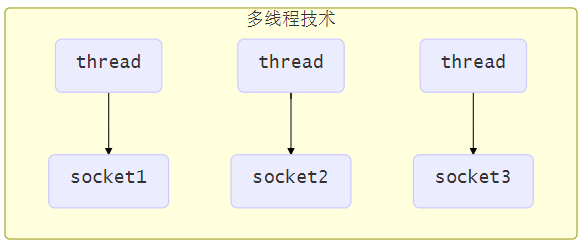
这种方法存在以下几个问题:
- 内存占用高
- 每个线程都需要占用一定的内存,当连接较多时,会开辟大量线程,导致占用大量内存
- 线程上下文切换成本高
- 只适合连接数少的场景
- 连接数过多,会导致创建很多线程,从而出现问题
2、使用线程池技术:使用线程池,让线程池中的线程去处理连接

这种方法存在以下几个问题:
- 阻塞模式下,线程仅能处理一个连接
- 线程池中的线程获取任务(task)后,只有当其执行完任务之后(断开连接后),才会去获取并执行下一个任务
- 若 socke 连接一直未断开,则其对应的线程就无法处理其他的 socke 连接
- 仅适合短连接场景
- 短连接即建立连接发送请求并响应后就立即断开,使得线程池中的线程可以快速处理其他连接
3、使用选择器
selector 的作用就是配合一个线程来管理多个 channel(fileChannel 因为是阻塞式的,所以无法使用 selector),获取这些 channel 上发生的事件,这些 channel 工作在非阻塞模式下,当一个 channel 中没有执行任务时,线程可以去执行其他 channel 中的任务。适合连接数特别多,但流量较少的场景。
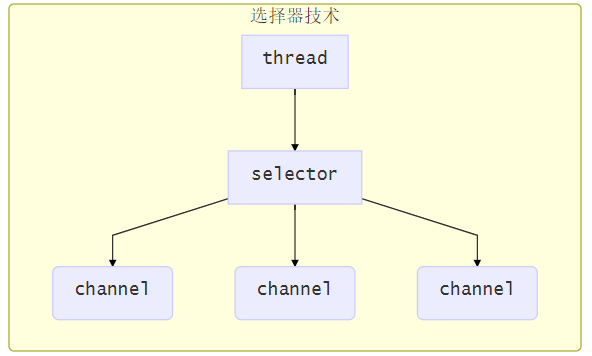
若事件未就绪,调用 selector 的 select( ) 方法会阻塞线程,直到 channel 发生了就绪事件。这些事件就绪后,select 方法就会返回这些事件交给 thread 来处理
2、ByteBuffer
有一个普通文本文件 data.txt,内容为:
1234567890abcd
使用 FileChannel 来读取文件内容:
@Slf4j
public class TestByteBuffer {public static void main(String[] args) {// FileChannel// 输入输出流try (FileChannel channel = new FileInputStream("data.txt").getChannel()) {// 准备缓冲区ByteBuffer buffer = ByteBuffer.allocate(10); // 缓冲区大小while (true) {// 从 channel 读取数据,向 buffer 写入int len = channel.read(buffer);log.debug("读取到的字节数 {}", len);if (len == -1) { // 没有内容了break;}// 打印 buffer 的内容buffer.flip(); // 切换到读模式while (buffer.hasRemaining()) { // 是否还有剩余未读字节byte b = buffer.get();log.debug("实际字节 {}", (char) b);}// 切换到写模式,清除已读内容buffer.clear();}} catch (IOException e) {throw new RuntimeException(e);}}}
输出:
16:28:48 [DEBUG] [main] c.i.n.c.TestByteBuffer - 读取到的字节数 10
16:28:48 [DEBUG] [main] c.i.n.c.TestByteBuffer - 实际字节 0
16:28:48 [DEBUG] [main] c.i.n.c.TestByteBuffer - 实际字节 1
16:28:48 [DEBUG] [main] c.i.n.c.TestByteBuffer - 实际字节 2
16:28:48 [DEBUG] [main] c.i.n.c.TestByteBuffer - 实际字节 3
16:28:48 [DEBUG] [main] c.i.n.c.TestByteBuffer - 实际字节 4
16:28:48 [DEBUG] [main] c.i.n.c.TestByteBuffer - 实际字节 5
16:28:48 [DEBUG] [main] c.i.n.c.TestByteBuffer - 实际字节 6
16:28:48 [DEBUG] [main] c.i.n.c.TestByteBuffer - 实际字节 7
16:28:48 [DEBUG] [main] c.i.n.c.TestByteBuffer - 实际字节 8
16:28:48 [DEBUG] [main] c.i.n.c.TestByteBuffer - 实际字节 9
16:28:48 [DEBUG] [main] c.i.n.c.TestByteBuffer - 读取到的字节数 4
16:28:48 [DEBUG] [main] c.i.n.c.TestByteBuffer - 实际字节 a
16:28:48 [DEBUG] [main] c.i.n.c.TestByteBuffer - 实际字节 b
16:28:48 [DEBUG] [main] c.i.n.c.TestByteBuffer - 实际字节 c
16:28:48 [DEBUG] [main] c.i.n.c.TestByteBuffer - 实际字节 16:28:48 [DEBUG] [main] c.i.n.c.TestByteBuffer - 读取到的字节数 -1
使用方式:
- 向 buffer 写入数据,例如调用 channel.read(buffer)
- 调用 flip( ) 切换至读模式
- flip 会使得 buffer 中的 limit 变为 position,position 变为 0
- 从 buffer 读取数据,例如调用 buffer.get( )
- 调用 clear( ) 或者 compact( ) 切换至写模式
- 调用 clear( ) 方法时 position=0,limit 变为 capacity
- 调用 compact( ) 方法时,会将缓冲区中的未读数据压缩到缓冲区前面
- 重复以上步骤
2.1、ByteBuffer 正确使用姿势
ByteBuffer 有以下重要属性:
- capacity
- position
- limit
步骤:
一开始

写模式下,position 是写入位置,limit 等于容量,下图表示写入了 4 个字节后的状态
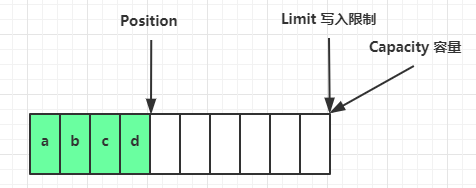
flip 动作发生后,position 切换为读取位置,limit 切换为读取限制
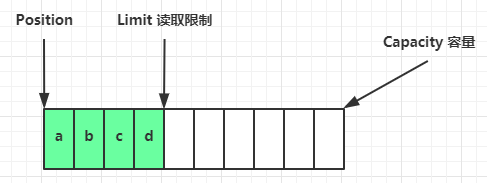
读取 4 个字节后,状态
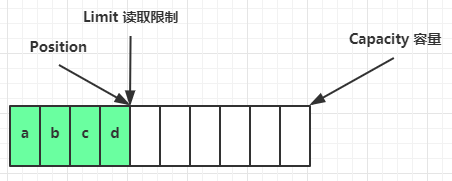
clear 动作发生后,状态
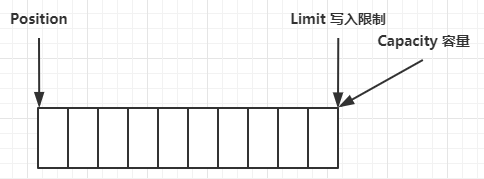
compact 方法,是把未读完的部分向前压缩,然后切换至写模式

调试工具类
public class ByteBufferUtil {private static final char[] BYTE2CHAR = new char[256];private static final char[] HEXDUMP_TABLE = new char[256 * 4];private static final String[] HEXPADDING = new String[16];private static final String[] HEXDUMP_ROWPREFIXES = new String[65536 >>> 4];private static final String[] BYTE2HEX = new String[256];private static final String[] BYTEPADDING = new String[16];static {final char[] DIGITS = "0123456789abcdef".toCharArray();for (int i = 0; i < 256; i++) {HEXDUMP_TABLE[i << 1] = DIGITS[i >>> 4 & 0x0F];HEXDUMP_TABLE[(i << 1) + 1] = DIGITS[i & 0x0F];}int i;// Generate the lookup table for hex dump paddingsfor (i = 0; i < HEXPADDING.length; i++) {int padding = HEXPADDING.length - i;StringBuilder buf = new StringBuilder(padding * 3);for (int j = 0; j < padding; j++) {buf.append(" ");}HEXPADDING[i] = buf.toString();}// Generate the lookup table for the start-offset header in each row (up to 64KiB).for (i = 0; i < HEXDUMP_ROWPREFIXES.length; i++) {StringBuilder buf = new StringBuilder(12);buf.append(NEWLINE);buf.append(Long.toHexString(i << 4 & 0xFFFFFFFFL | 0x100000000L));buf.setCharAt(buf.length() - 9, '|');buf.append('|');HEXDUMP_ROWPREFIXES[i] = buf.toString();}// Generate the lookup table for byte-to-hex-dump conversionfor (i = 0; i < BYTE2HEX.length; i++) {BYTE2HEX[i] = ' ' + StringUtil.byteToHexStringPadded(i);}// Generate the lookup table for byte dump paddingsfor (i = 0; i < BYTEPADDING.length; i++) {int padding = BYTEPADDING.length - i;StringBuilder buf = new StringBuilder(padding);for (int j = 0; j < padding; j++) {buf.append(' ');}BYTEPADDING[i] = buf.toString();}// Generate the lookup table for byte-to-char conversionfor (i = 0; i < BYTE2CHAR.length; i++) {if (i <= 0x1f || i >= 0x7f) {BYTE2CHAR[i] = '.';} else {BYTE2CHAR[i] = (char) i;}}}/*** 打印所有内容* @param buffer*/public static void debugAll(ByteBuffer buffer) {int oldlimit = buffer.limit();buffer.limit(buffer.capacity());StringBuilder origin = new StringBuilder(256);appendPrettyHexDump(origin, buffer, 0, buffer.capacity());System.out.println("+--------+-------------------- all ------------------------+----------------+");System.out.printf("position: [%d], limit: [%d]\n", buffer.position(), oldlimit);System.out.println(origin);buffer.limit(oldlimit);}/*** 打印可读取内容* @param buffer*/public static void debugRead(ByteBuffer buffer) {StringBuilder builder = new StringBuilder(256);appendPrettyHexDump(builder, buffer, buffer.position(), buffer.limit() - buffer.position());System.out.println("+--------+-------------------- read -----------------------+----------------+");System.out.printf("position: [%d], limit: [%d]\n", buffer.position(), buffer.limit());System.out.println(builder);}private static void appendPrettyHexDump(StringBuilder dump, ByteBuffer buf, int offset, int length) {if (isOutOfBounds(offset, length, buf.capacity())) {throw new IndexOutOfBoundsException("expected: " + "0 <= offset(" + offset + ") <= offset + length(" + length+ ") <= " + "buf.capacity(" + buf.capacity() + ')');}if (length == 0) {return;}dump.append(" +-------------------------------------------------+" +NEWLINE + " | 0 1 2 3 4 5 6 7 8 9 a b c d e f |" +NEWLINE + "+--------+-------------------------------------------------+----------------+");final int startIndex = offset;final int fullRows = length >>> 4;final int remainder = length & 0xF;// Dump the rows which have 16 bytes.for (int row = 0; row < fullRows; row++) {int rowStartIndex = (row << 4) + startIndex;// Per-row prefix.appendHexDumpRowPrefix(dump, row, rowStartIndex);// Hex dumpint rowEndIndex = rowStartIndex + 16;for (int j = rowStartIndex; j < rowEndIndex; j++) {dump.append(BYTE2HEX[getUnsignedByte(buf, j)]);}dump.append(" |");// ASCII dumpfor (int j = rowStartIndex; j < rowEndIndex; j++) {dump.append(BYTE2CHAR[getUnsignedByte(buf, j)]);}dump.append('|');}// Dump the last row which has less than 16 bytes.if (remainder != 0) {int rowStartIndex = (fullRows << 4) + startIndex;appendHexDumpRowPrefix(dump, fullRows, rowStartIndex);// Hex dumpint rowEndIndex = rowStartIndex + remainder;for (int j = rowStartIndex; j < rowEndIndex; j++) {dump.append(BYTE2HEX[getUnsignedByte(buf, j)]);}dump.append(HEXPADDING[remainder]);dump.append(" |");// Ascii dumpfor (int j = rowStartIndex; j < rowEndIndex; j++) {dump.append(BYTE2CHAR[getUnsignedByte(buf, j)]);}dump.append(BYTEPADDING[remainder]);dump.append('|');}dump.append(NEWLINE +"+--------+-------------------------------------------------+----------------+");}private static void appendHexDumpRowPrefix(StringBuilder dump, int row, int rowStartIndex) {if (row < HEXDUMP_ROWPREFIXES.length) {dump.append(HEXDUMP_ROWPREFIXES[row]);} else {dump.append(NEWLINE);dump.append(Long.toHexString(rowStartIndex & 0xFFFFFFFFL | 0x100000000L));dump.setCharAt(dump.length() - 9, '|');dump.append('|');}}public static short getUnsignedByte(ByteBuffer buffer, int index) {return (short) (buffer.get(index) & 0xFF);}
}
public class TestByteBufferReadWrite {public static void main(String[] args) {ByteBuffer buffer = ByteBuffer.allocate(10);// 写入数据到缓冲区buffer.put((byte) 0x61); // 十六进制0x61 -> 'a'debugAll(buffer);// 写入数据到缓冲区buffer.put(new byte[]{0x62, 0x63, 0x64}); // b c ddebugAll(buffer);// 不切换成读模式,直接读取数据System.out.println(buffer.get()); // 0// 切换成读模式buffer.flip();System.out.println(buffer.get()); // 0x61(十六进制) = 97(十进制)debugAll(buffer);// 切换成写模式,并把未读到的值往前移buffer.compact();debugAll(buffer);// 写入数据到缓冲区buffer.put(new byte[]{0x65, 0x6f});debugAll(buffer);}}
2.2、ByteBuffer 常见方法
分配空间
可以使用 allocate 方法为 ByteBuffer 分配空间,其它 buffer 类也有该方法
Bytebuffer buffer = ByteBuffer.allocate(16);
public class TestByteBufferAllocate {public static void main(String[] args) {/*** class java.nio.HeapByteBuffer - java 堆内存,读写效率较低,受到 GC 的影响* class java.nio.DirectByteBuffer - 系统内存(直接内存),读写效率高(少一次拷贝),不会受 GC 影响,分配的效率低*/System.out.println(ByteBuffer.allocate(16).getClass());System.out.println(ByteBuffer.allocateDirect(16).getClass());}}
向 buffer 写入数据
有两种办法:
- 调用 channel 的 read 方法
- 调用 buffer 自己的 put 方法
int readBytes = channel.read(buf);// 和buffer.put((byte)127);
从 buffer 读取数据
同样有两种办法
- 调用 channel 的 write 方法
- 调用 buffer 自己的 get 方法
int writeBytes = channel.write(buf);// 和byte b = buffer.get();
注意:get 方法会让 position 读指针往后走,如果想重复读取数据
- 可以调用 rewind 方法将 position 重新置为 0
- 或者调用
get(int i)方法获取索引 i 的内容,它不会移动读指针
mark 和 reset
mark 是在读取时,做一个标记,即使 position 改变,只要调用 reset 就能回到 mark 的位置
注意
rewind 和 flip 都会清除 mark 位置
代码示例
public class TestByteBufferRead {public static void main(String[] args) {ByteBuffer buffer = ByteBuffer.allocate(10);buffer.put(new byte[]{'a', 'b', 'c', 'd'});// 切换到读模式buffer.flip();// // 一次性读取 4 个字节
// buffer.get(new byte[4]);
// debugAll(buffer);
// // rewind 从头开始读
// buffer.rewind();
// System.out.println((char) buffer.get()); // a/*** mark & reset* mark 是做一个标记,记录 position 位置* reset 是将 position 重置到 mark 的位置*/
// debugAll(buffer);
// System.out.println((char) buffer.get()); // a
// System.out.println((char) buffer.get()); // b
// buffer.mark(); // 加标记,索引 2 的位置
// System.out.println((char) buffer.get()); // c
// System.out.println((char) buffer.get()); // d
// buffer.reset(); // 将 position 重置到索引 2
// System.out.println((char) buffer.get()); // c
// System.out.println((char) buffer.get()); // d// get(i) 不会改变读索引的位置
// debugAll(buffer);
// System.out.println((char) buffer.get(3));}
}
2.3、字符串与 ByteBuffer 互转
public class TestByteBufferString {public static void main(String[] args) {// 1. 字符串转为 ByteBuffer,不会切换到读模式ByteBuffer buffer1 = ByteBuffer.allocate(16);buffer1.put("hello".getBytes());debugAll(buffer1);// 2. Charset,会切换到读模式ByteBuffer buffer2 = StandardCharsets.UTF_8.encode("hello");debugAll(buffer2);// 3. wrap,会切换到读模式ByteBuffer buffer3 = ByteBuffer.wrap("hello".getBytes());debugAll(buffer3);// 4. ByteBuffer 转为字符串String str1 = StandardCharsets.UTF_8.decode(buffer2).toString();System.out.println(str1);// 因为 buffer1 不是读模式,所以这里需要手动切换到读模式buffer1.flip();String str2 = StandardCharsets.UTF_8.decode(buffer1).toString();System.out.println(str2);}}
+--------+-------------------- all ------------------------+----------------+
position: [5], limit: [16]+-------------------------------------------------+| 0 1 2 3 4 5 6 7 8 9 a b c d e f |
+--------+-------------------------------------------------+----------------+
|00000000| 68 65 6c 6c 6f 00 00 00 00 00 00 00 00 00 00 00 |hello...........|
+--------+-------------------------------------------------+----------------++--------+-------------------- all ------------------------+----------------+
position: [0], limit: [5]+-------------------------------------------------+| 0 1 2 3 4 5 6 7 8 9 a b c d e f |
+--------+-------------------------------------------------+----------------+
|00000000| 68 65 6c 6c 6f |hello |
+--------+-------------------------------------------------+----------------++--------+-------------------- all ------------------------+----------------+
position: [0], limit: [5]+-------------------------------------------------+| 0 1 2 3 4 5 6 7 8 9 a b c d e f |
+--------+-------------------------------------------------+----------------+
|00000000| 68 65 6c 6c 6f |hello |
+--------+-------------------------------------------------+----------------+hellohello
Buffer 的线程安全
注意:Buffer 是非线程安全的
2.4、Scattering Reads
分散读取,有一个文本文件 words.txt
onetwothree
使用如下方式读取,可以将数据填充至多个 buffer:
public class TestScatteringReads {public static void main(String[] args) {try (FileChannel channel = new RandomAccessFile("words.txt", "r").getChannel()) {ByteBuffer b1 = ByteBuffer.allocate(3);ByteBuffer b2 = ByteBuffer.allocate(3);ByteBuffer b3 = ByteBuffer.allocate(5);channel.read(new ByteBuffer[]{b1, b2, b3});b1.flip();b2.flip();b3.flip();debugAll(b1);debugAll(b2);debugAll(b3);} catch (IOException e) {}}}
结果:
+--------+-------------------- all ------------------------+----------------+
position: [0], limit: [3]+-------------------------------------------------+| 0 1 2 3 4 5 6 7 8 9 a b c d e f |
+--------+-------------------------------------------------+----------------+
|00000000| 6f 6e 65 |one |
+--------+-------------------------------------------------+----------------++--------+-------------------- all ------------------------+----------------+
position: [0], limit: [3]+-------------------------------------------------+| 0 1 2 3 4 5 6 7 8 9 a b c d e f |
+--------+-------------------------------------------------+----------------+
|00000000| 74 77 6f |two |
+--------+-------------------------------------------------+----------------++--------+-------------------- all ------------------------+----------------+
position: [0], limit: [5]+-------------------------------------------------+| 0 1 2 3 4 5 6 7 8 9 a b c d e f |
+--------+-------------------------------------------------+----------------+
|00000000| 74 68 72 65 65 |three |
+--------+-------------------------------------------------+----------------+
2.5、Gathering Writes
使用如下方式写入,可以将多个 buffer 的数据进行集中写入,提高效率
public class TestGatheringWrites {public static void main(String[] args) {ByteBuffer b1 = StandardCharsets.UTF_8.encode("hello");ByteBuffer b2 = StandardCharsets.UTF_8.encode("world");ByteBuffer b3 = StandardCharsets.UTF_8.encode("你好");try (FileChannel channel = new RandomAccessFile("words2.txt", "rw").getChannel()) {channel.write(new ByteBuffer[]{b1, b2, b3});} catch (IOException e) {}}}
2.6、粘包与半包
现象
网络上有多条数据要发送给服务端,数据之间使用 \n 进行分隔
但由于某种原因这些数据在接收时,被进行了重新组合,例如原始数据有3条,分别为
- Hello,world\n
- I’m Nyima\n
- How are you?\n
变成了下面的两个 byteBuffer (粘包,半包)
- Hello,world\nI’m Nyima\nHo
- w are you?\n
出现原因
粘包
发送方在发送数据时,并不是一条一条地发送数据,而是将数据整合在一起,当数据达到一定的数量后再一起发送。这就会导致多条信息被放在一个缓冲区中被一起发送出去
半包
接收方的缓冲区的大小是有限的,当接收方的缓冲区满了以后,就需要将信息截断,等缓冲区空了以后再继续放入数据。这就会发生一段完整的数据最后被截断的现象
解决办法
- 通过 get(index) 方法遍历 ByteBuffer,遇到分隔符时进行处理。注意:get(index)不会改变position的值
- 记录该段数据长度,以便于申请对应大小的缓冲区
- 将缓冲区的数据通过get()方法写入到target中
- 调用compact方法切换模式,因为缓冲区中可能还有未读的数据
public class TestByteBufferExam {public static void main(String[] args) {/*网络上有多条数据发送给服务端,数据之间使用 \n 进行分隔但由于某种原因这些数据在接收时,被进行了重新组合,例如原始数据有3条为Hello,world\nI'm zhangsan\nHow are you?\n变成了下面的两个 byteBuffer (黏包,半包)Hello,world\nI'm zhangsan\nHow are you?\n现在要求你编写程序,将错乱的数据恢复成原始的按 \n 分隔的数据*/ByteBuffer source = ByteBuffer.allocate(32);source.put("Hello,world\nI'm zhangsan\nHo".getBytes());split(source);source.put("w are you?\n".getBytes());split(source);}private static void split(ByteBuffer source) {// 切换到读模式source.flip();// 遍历ByteBuffer的每一个节点for (int i = 0; i < source.limit(); i++) {// 找到一条完整消息if (source.get(i) == '\n') {// 每条信息的长度等于:换行符的索引位置 + 1 - 当前position的索引位置int length = i + 1 - source.position();// 把这条完整消息存入新的 ByteBufferByteBuffer target = ByteBuffer.allocate(length);// 从 source 读,向 target 写for (int j = 0; j < length; j++) {target.put(source.get());}debugAll(target);}}// 把未读的数据移到缓冲区的最前面,然后再开启写模式source.compact();}}
结果:
+--------+-------------------- all ------------------------+----------------+
position: [12], limit: [12]+-------------------------------------------------+| 0 1 2 3 4 5 6 7 8 9 a b c d e f |
+--------+-------------------------------------------------+----------------+
|00000000| 48 65 6c 6c 6f 2c 77 6f 72 6c 64 0a |Hello,world. |
+--------+-------------------------------------------------+----------------++--------+-------------------- all ------------------------+----------------+
position: [13], limit: [13]+-------------------------------------------------+| 0 1 2 3 4 5 6 7 8 9 a b c d e f |
+--------+-------------------------------------------------+----------------+
|00000000| 49 27 6d 20 7a 68 61 6e 67 73 61 6e 0a |I'm zhangsan. |
+--------+-------------------------------------------------+----------------++--------+-------------------- all ------------------------+----------------+
position: [13], limit: [13]+-------------------------------------------------+| 0 1 2 3 4 5 6 7 8 9 a b c d e f |
+--------+-------------------------------------------------+----------------+
|00000000| 48 6f 77 20 61 72 65 20 79 6f 75 3f 0a |How are you?. |
+--------+-------------------------------------------------+----------------+
3、文件编程
3.1、FileChannel
注意
FileChannel 只能在阻塞模式下工作,所以无法搭配 Selector
获取
不能直接打开 FileChannel,必须通过 FileInputStream、FileOutputStream 或者 RandomAccessFile 来获取 FileChannel,它们都有 getChannel 方法
- 通过 FileInputStream 获取的 channel 只能读
- 通过 FileOutputStream 获取的 channel 只能写
- 通过 RandomAccessFile 是否能读写,根据构造 RandomAccessFile 时的读写模式决定
读取
通过 FileInputStream 获取 channel,通过 read 方法将数据写入到 ByteBuffer 中
read 方法的返回值表示读到了多少字节,若读到了文件末尾则返回-1
int readBytes = channel.read(buffer);
可根据返回值判断是否读取完毕
while(channel.read(buffer) > 0) {// 进行对应操作...
}
写入
因为 channel 也是有大小限制的,所以 write 方法并不能保证一次性将 buffer 中的内容全部写入 channel。必须按照以下规则进行写入
// 通过hasRemaining()方法查看缓冲区中是否还有数据未写入到通道中
while(buffer.hasRemaining()) {channel.write(buffer);
}
关闭
channel 必须关闭,不过调用了 FileInputStream、FileOutputStream 或者 RandomAccessFile 的 close 方法会间接地调用 channel 的 close 方法
一般通过 try-with-resource 进行关闭
public class TestChannel {public static void main(String[] args) throws IOException {try (FileInputStream fis = new FileInputStream("stu.txt");FileOutputStream fos = new FileOutputStream("student.txt");FileChannel inputChannel = fis.getChannel();FileChannel outputChannel = fos.getChannel()) {// 执行对应操作...} catch (IOException e) {}}
}
位置
获取当前位置
long pos = channel.position();
设置当前位置
long newPos = ...;
channel.position(newPos);
设置当前位置时,如果设置为文件的末尾
- 这时读取会返回 -1
- 这时写入,会追加内容,但要注意如果 position 超过了文件末尾,那么写入时在新内容和原末尾之间会有空洞(00)
大小
使用 size 方法获取文件的大小
强制写入
操作系统出于性能的考虑,调用写入时通常不会立刻写入到磁盘,而是会将数据进行缓存(pageCache)。可以调用 force(true) 方法将文件内容和元数据(文件的权限等信息)立刻写入磁盘
3.2、两个 Channel 传输数据
public class TestFileChannelTransferTo {public static void main(String[] args) {try (FileChannel from = new FileInputStream("data.txt").getChannel();FileChannel to = new FileOutputStream("to.txt").getChannel();) {// 效率高,底层会利用操作系统的零拷贝进行优化, 一次最多传 2g 数据long size = from.size();// left 变量代表还剩余多少字节for (long left = size; left > 0; ) {System.out.println("position:" + (size - left) + " left:" + left);/*** 第一个参数:传输的起始位置* 第二个参数:要传输多少数据* 第三个参数:传输到什么地方* 返回的是实际传输的字节数*/left -= from.transferTo((size - left), left, to);}} catch (IOException e) {e.printStackTrace();}}}
输出
position:0 left:14
3.3、Path
jdk7 引入了 Path 和 Paths 类
- Path 用来表示文件路径
- Paths 是工具类,用来获取 Path 实例
Path source = Paths.get("1.txt"); // 相对路径 使用 user.dir 环境变量来定位 1.txtPath source = Paths.get("d:\\1.txt"); // 绝对路径 代表了 d:\1.txtPath source = Paths.get("d:/1.txt"); // 绝对路径 同样代表了 d:\1.txtPath projects = Paths.get("d:\\data", "projects"); // 代表了 d:\data\projects
.代表了当前路径..代表了上一级路径
例如目录结构如下:
d:|- data|- projects|- a|- b
代码:
Path path = Paths.get("d:\\data\\projects\\a\\..\\b");
System.out.println(path);
System.out.println(path.normalize()); // 正常化路径
会输出:
d:\data\projects\a\..\b
d:\data\projects\b
3.4、Files
检查文件是否存在:
Path path = Paths.get("helloword/data.txt");
System.out.println(Files.exists(path));
创建一级目录:
Path path = Paths.get("helloword/d1");
Files.createDirectory(path);
- 如果目录已存在,会抛异常 FileAlreadyExistsException
- 不能一次性创建多级目录,否则会抛异常 NoSuchFileException
创建多级目录用
Path path = Paths.get("helloword/d1/d2");
Files.createDirectories(path);
拷贝文件
Path source = Paths.get("helloword/data.txt");
Path target = Paths.get("helloword/target.txt");Files.copy(source, target);
- 如果文件已存在,会抛异常 FileAlreadyExistsException
- 如果希望用 source 覆盖掉 target,需要用 StandardCopyOption 来控制
Files.copy(source, target, StandardCopyOption.REPLACE_EXISTING);
移动文件
Path source = Paths.get("helloword/data.txt");
Path target = Paths.get("helloword/data.txt");// StandardCopyOption.ATOMIC_MOVE 保证文件移动的原子性
Files.move(source, target, StandardCopyOption.ATOMIC_MOVE);
删除文件
Path target = Paths.get("helloword/target.txt");Files.delete(target);
如果文件不存在,会抛异常 NoSuchFileException
删除目录
Path target = Paths.get("helloword/d1");Files.delete(target);
如果目录下还有内容,会抛异常 DirectoryNotEmptyException
遍历目录文件
/*** 遍历指定目录下的所有文件夹和所有文件** @throws IOException*/private static void m1() throws IOException {// 文件夹个数AtomicInteger dircount = new AtomicInteger();// 文件个数AtomicInteger filecount = new AtomicInteger();Files.walkFileTree(Paths.get("/Users/xiexu/图灵"), new SimpleFileVisitor<Path>() {/*** 遍历到文件时所做的操作* @return* @throws IOException*/@Overridepublic FileVisitResult visitFile(Path file, BasicFileAttributes attrs) throws IOException {// 打印文件System.out.println(file);filecount.incrementAndGet();return super.visitFile(file, attrs);}/*** 进入文件夹以后所做的操作* @return* @throws IOException*/@Overridepublic FileVisitResult postVisitDirectory(Path dir, IOException exc) throws IOException {// 打印文件夹System.out.println("===>" + dir);dircount.incrementAndGet();return super.postVisitDirectory(dir, exc);}});System.out.println("filecount = " + filecount);System.out.println("dircount = " + dircount);}
查看指定目录下有多少个jar包
/*** 查看当前目录下有多少个jar包** @throws IOException*/private static void m2() throws IOException {AtomicInteger jarCount = new AtomicInteger();Files.walkFileTree(Paths.get("/Users/xiexu/图灵"), new SimpleFileVisitor<Path>() {/*** 遍历到文件时所做的操作* @return* @throws IOException*/@Overridepublic FileVisitResult visitFile(Path file, BasicFileAttributes attrs) throws IOException {// 判断文件是否以.jar结尾if (file.toString().endsWith(".jar")) {System.out.println(file);jarCount.incrementAndGet();}return super.visitFile(file, attrs);}});System.out.println("jar count:" + jarCount);}
删除多级目录
/*** 删除多级目录下的所有文件,步骤:* 1、进入目录之前应该不能删除,因为目录下面还有很多文件和子目录* 2、遍历到文件后就可以挨个删除* 3、进入目录之后,也就是相当于退出目录的时候,就可以执行删除当前目录的操作了,因为当前目录下的文件和子目录都已经被删除了*/public static void m3() throws IOException {Files.walkFileTree(Paths.get("/Users/xiexu/图灵"), new SimpleFileVisitor<Path>() {/*** 进入目录之前所做的操作* @return* @throws IOException*/@Overridepublic FileVisitResult preVisitDirectory(Path dir, BasicFileAttributes attrs) throws IOException {System.out.println("====> 进入" + dir);return super.preVisitDirectory(dir, attrs);}/*** 遍历到文件后所做的操作* @return* @throws IOException*/@Overridepublic FileVisitResult visitFile(Path file, BasicFileAttributes attrs) throws IOException {Files.delete(file);return super.visitFile(file, attrs);}/*** 进入目录之后的操作* @return* @throws IOException*/@Overridepublic FileVisitResult postVisitDirectory(Path dir, IOException exc) throws IOException {Files.delete(dir);return super.postVisitDirectory(dir, exc);}});}
删除很危险
删除是危险操作,确保要递归删除的目录下没有重要内容,否则一旦删除了,那么这个操作是不可逆的!
拷贝多级目录
public class TestFilesCopy {/*** 拷贝多级目录** @param args* @throws IOException*/public static void main(String[] args) throws IOException {long start = System.currentTimeMillis();String source = "/Users/xiexu/微信公众号开发全套资料";String target = "/Users/xiexu/微信公众号开发全套资料2";Files.walk(Paths.get(source)).forEach(path -> {try {/*** 将源文件夹的路径替换成目标文件夹的路径*/String targetName = path.toString().replace(source, target);// 如果是目录,就需要到目的文件夹上面创建相同的目录if (Files.isDirectory(path)) {Files.createDirectory(Paths.get(targetName));}// 如果是普通文件,则拷贝当前文件到目的文件夹中else if (Files.isRegularFile(path)) {Files.copy(path, Paths.get(targetName));}} catch (IOException e) {e.printStackTrace();}});long end = System.currentTimeMillis();System.out.println(end - start);}
}
4、网络编程
4.1、阻塞 VS 非阻塞
阻塞
- 阻塞模式下,相关方法都会导致线程暂停
- ServerSocketChannel.accept 会在没有新的连接建立时让线程暂停
- SocketChannel.read 会在没有数据可读时让线程暂停
- 阻塞的表现其实就是线程暂停了,暂停期间不会占用 cpu,但线程相当于闲置
- 单线程下,阻塞方法之间相互影响,几乎不能正常工作,需要多线程支持
- 但多线程下,有新的问题,体现在以下方面
- 32 位 jvm 一个线程 320 k,64 位 jvm 一个线程 1024 k,如果连接数过多,必然导致 OOM,并且线程太多,反而会因为频繁上下文切换导致性能降低
- 可以采用线程池技术来减少线程数和线程上下文切换,但治标不治本,如果有很多连接建立,但长时间 inactive,会阻塞线程池中所有线程,因此不适合长连接,只适合短连接
服务器端
/*** 服务端*/
@Slf4j
public class Server {public static void main(String[] args) throws IOException {// 使用 nio 来理解阻塞模式,单线程// 0、ByteBufferByteBuffer buffer = ByteBuffer.allocate(16);// 1、创建服务器ServerSocketChannel ssc = ServerSocketChannel.open();// 2、绑定监听端口ssc.bind(new InetSocketAddress(8080));// 3、建立一个连接的集合List<SocketChannel> channels = new ArrayList<>();while (true) {log.debug("connecting...");// 4、建立与客户端的连接,SocketChannel 用来与客户端之间通信SocketChannel sc = ssc.accept(); // 如果没有新的客户端线程建立连接,那么accept方法就会阻塞,线程停止运行(不会占用CPU时间)log.debug("connected...{}", sc);channels.add(sc);for (SocketChannel channel : channels) {// 5、接收客户端发送的数据log.debug("before read...{}", channel);// channel 读,buffer 写channel.read(buffer); // 如果没有数据可以读,那么read方法就会阻塞,线程停止运行(不会占用CPU时间)// 切换到读模式buffer.flip();debugRead(buffer);buffer.clear();log.debug("after read...{}", channel);}}}}
客户端
/*** 客户端*/
public class Client {public static void main(String[] args) throws IOException {// 创建一个客户端SocketChannel sc = SocketChannel.open();// 链接到服务器sc.connect(new InetSocketAddress("localhost", 8080));System.out.println("waiting...");}}
运行结果:
- 客户端-服务器建立连接前:服务器端因 accept 阻塞

- 客户端-服务器建立连接后,客户端发送消息前:服务器端因通道为空被阻塞
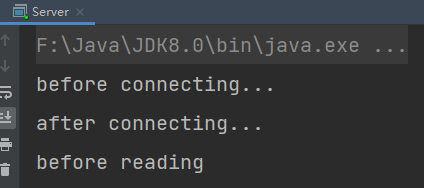
- 客户端发送数据后,服务器处理通道中的数据。再次进入循环时,再次被 accept 阻塞
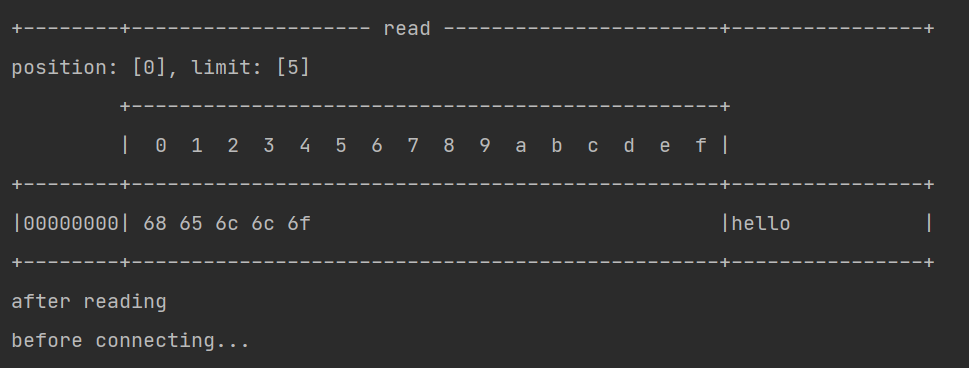
- 之前的客户端再次发送消息,服务器端因为被 accept 阻塞,无法处理之前客户端发送到通道中的信息

非阻塞
- 非阻塞模式下,相关方法都不会让线程暂停
- ServerSocketChannel.accept 在没有连接建立时,会返回 null,继续运行
- SocketChannel.read 在没有数据可读时,会返回 0,但线程不必阻塞,可以去执行其它 SocketChannel 的 read 或是去执行 ServerSocketChannel.accept
- 写数据时,线程只是等待数据写入 Channel 即可,无需等 Channel 通过网络把数据发送出去
- 但非阻塞模式下,即使没有连接建立,和可读数据,线程仍然在不断运行,白白浪费了 CPU
- 数据复制过程中,线程实际还是阻塞的(AIO 改进的地方)
/*** 服务端*/
@Slf4j
public class Server {public static void main(String[] args) throws IOException {// 使用 nio 来理解非阻塞模式,单线程// 0、ByteBufferByteBuffer buffer = ByteBuffer.allocate(16);// 1、创建服务器ServerSocketChannel ssc = ServerSocketChannel.open();// 配置非阻塞模式(默认是阻塞模式)ssc.configureBlocking(false);// 2、绑定监听端口ssc.bind(new InetSocketAddress(8080));// 3、建立一个连接的集合List<SocketChannel> channels = new ArrayList<>();while (true) {// 4、建立与客户端的连接,SocketChannel 用来与客户端之间通信SocketChannel sc = ssc.accept(); // 非阻塞,线程还会继续运行,如果没有连接建立,sc返回是nullif (sc != null) {log.debug("connected...{}", sc);// 配置非阻塞模式(默认是阻塞模式)sc.configureBlocking(false);channels.add(sc);}for (SocketChannel channel : channels) {// 5、接收客户端发送的数据// channel 读,buffer 写int read = channel.read(buffer); // 非阻塞,线程还会继续运行,如果没有数据可读,read返回是0if (read > 0) {// 切换到读模式buffer.flip();debugRead(buffer);buffer.clear();log.debug("after read...{}", channel);}}}}}
这样写存在一个问题,因为设置了非阻塞,会一直执行 while(true) 中的代码,CPU一直处于忙碌状态,会使得性能变低,所以实际情况中不会使用这种方式来处理请求
多路复用
单线程可以配合 Selector 完成对多个 Channel 可读写事件的监控,这称之为多路复用(只有事件发生了,Selector 才会让线程继续运行;如果事件没有发生,那么 Selector 是阻塞的)
- 多路复用仅针对网络 IO,普通文件 IO 是无法利用多路复用的
- 如果不用 Selector 的非阻塞模式,线程大部分时间都在做无用功,而 Selector 能够保证
- 有可连接事件时才去连接
- 有可读事件时才去读取
- 有可写事件时才去写入
- 限于网络传输能力,Channel 未必时时可写,一旦 Channel 可写,会触发 Selector 的可写事件
4.2、Selector
使用 Selector 带来的好处:
- 一个线程配合 selector 就可以监控多个 channel 的事件,事件发生线程才去处理。避免非阻塞模式下所做无用功
- 让这个线程能够被充分利用
- 节约了线程的数量
- 减少了线程上下文切换
创建
Selector selector = Selector.open();
绑定 Channel 事件
将一个 Channel 注册到一个 Selector 上,以便 Selector 可以监听和关心该 Channel 上发生的特定事件。
// 配置非阻塞模式
channel.configureBlocking(false);
SelectionKey key = channel.register(selector, 绑定事件);
- channel 必须工作在非阻塞模式
- FileChannel 没有非阻塞模式,因此不能配合 selector 一起使用
绑定的事件类型可以有:
- connect:客户端连接成功时触发
- accept:服务器端成功接受连接时触发
- read:数据可读入时触发,是因为接收能力弱,导致数据暂时不能读入的情况
- write:数据可写出时触发,是因为发送能力弱,导致数据暂时不能写出的情况
监听 Channel 事件
可以通过下面三种方法来监听是否有事件发生,方法的返回值代表有多少 channel 发生了事件:
方法一:阻塞直到绑定事件发生
int count = selector.select();
方法二:阻塞直到绑定事件发生,或是超时(时间单位为 ms,比如 1 秒内没有事件发生,那么超过 1 秒后它就会继续运行不会阻塞了)
int count = selector.select(long timeout);
方法三:不会阻塞,也就是不管有没有事件,立刻返回,自己根据返回值检查是否有事件
int count = selector.selectNow();
select 何时不阻塞:
- 事件发生时
- 客户端发起连接请求,会触发 accept 事件
- 客户端发送数据过来,客户端正常、异常关闭时,都会触发 read 事件,另外如果发送的数据大于 buffer 缓冲区,会触发多次 read 事件
- channel 可写,会触发 write 事件
- 在 linux 下 nio bug 发生时
- 调用 selector.wakeup( )
- 调用 selector.close( )
- selector 所在线程 interrupt
4.3、处理 Accpet 事件
客户端代码为:
/*** 客户端*/
public class Client {public static void main(String[] args) throws IOException {// 创建一个客户端SocketChannel sc = SocketChannel.open();// 链接到服务器sc.connect(new InetSocketAddress("localhost", 8080));System.out.println("waiting...");}}
服务端代码为:
public class SelectServer {public static void main(String[] args) {ByteBuffer buffer = ByteBuffer.allocate(16);// 获得服务器通道try(ServerSocketChannel server = ServerSocketChannel.open()) {server.bind(new InetSocketAddress(8080));// 创建选择器Selector selector = Selector.open();// 通道必须设置为非阻塞模式server.configureBlocking(false);// 将通道注册到选择器中,并设置关注的事件server.register(selector, SelectionKey.OP_ACCEPT);while (true) {// 若没有事件就绪,线程会被阻塞,反之不会被阻塞。从而避免了CPU空转// select 方法在事件未处理时,它不会阻塞;如果事件已经处理了,它才会阻塞// 返回值为就绪的事件个数int ready = selector.select();System.out.println("selector ready counts : " + ready);// 获取所有事件Set<SelectionKey> selectionKeys = selector.selectedKeys();// 使用迭代器遍历所有事件,逐一处理Iterator<SelectionKey> iterator = selectionKeys.iterator();while (iterator.hasNext()) {SelectionKey key = iterator.next();// 判断事件的类型if(key.isAcceptable()) {// 获得key对应的channelServerSocketChannel channel = (ServerSocketChannel) key.channel();System.out.println("before accepting...");// 获取连接并处理,而且是必须处理,否则需要取消SocketChannel socketChannel = channel.accept();System.out.println("after accepting...");// 处理完毕后移除iterator.remove();}}}} catch (IOException e) {e.printStackTrace();}}}
事件发生后能否不处理 ?
事件发生后,要么处理,要么取消(cancel),不能什么都不做,否则下次该事件仍会触发,这是因为 nio 底层使用的是水平触发
4.4、处理 Read 事件
/*** 服务端*/
@Slf4j
public class Server {public static void main(String[] args) throws IOException {// 1、创建 selector,管理多个 channelSelector selector = Selector.open();// 创建选择器ServerSocketChannel ssc = ServerSocketChannel.open();// 绑定监听端口ssc.bind(new InetSocketAddress(8080));// 通道必须设置为非阻塞模式ssc.configureBlocking(false);// 2、建立 selector 和 channel 之间的联系(注册)// SelectionKey 就是将来事件发生后,通过它可以知道是和哪个 channel 发生的事件SelectionKey sscKey = ssc.register(selector, 0, null);// 当前 sscKey 只关注 accept 事件sscKey.interestOps(SelectionKey.OP_ACCEPT);log.debug("register key: {}", sscKey);while (true) {// 3、select 方法,如果没有事件发生,那么线程阻塞;如果有事件,线程才会恢复运行// select 方法在事件未处理时,它不会阻塞;如果事件已经处理,它才会阻塞int ready = selector.select();log.debug("selected ready counts: {}", ready);// 4、处理事件,selectedKeys 内部包含了所有发生的事件Set<SelectionKey> selectionKeys = selector.selectedKeys();// 使用迭代器遍历事件Iterator<SelectionKey> iter = selectionKeys.iterator();while (iter.hasNext()) {SelectionKey key = iter.next();log.debug("key: {}", key);// 5、区分事件类型if (key.isAcceptable()) { // 如果是 accept 事件// 获取key对应的channelServerSocketChannel channel = (ServerSocketChannel) key.channel();log.debug("before accepting...");/*** 事件发生后要么处理,要么取消,不能置之不理* accept 事件只会触发一次,如果不取消,下次 select 的时候,这个事件还会在 selectedKeys 中* 获取连接*/SocketChannel sc = channel.accept();log.debug("after accepting...");// 设置非阻塞模式sc.configureBlocking(false);// 将连接的通道注册到 selector 上SelectionKey scKey = sc.register(selector, 0, null);// 当前 scKey 只关注 read 事件scKey.interestOps(SelectionKey.OP_READ);log.debug("{}", sc);// 处理完毕后,要记得从迭代器中删除当前的 key,防止重复处理iter.remove();} else if (key.isReadable()) { // 如果是 read 事件try {// 拿到触发事件的 channelSocketChannel channel = (SocketChannel) key.channel();ByteBuffer buffer = ByteBuffer.allocate(16);// 如果是客户端正常断开,会返回 -1;如果是正常情况,会返回读取的字节数int read = channel.read(buffer);if (read == -1) {key.channel();} else {buffer.flip();debugRead(buffer);}// 处理完毕后,要记得从迭代器中删除当前的 key,防止重复处理iter.remove();} catch (IOException e) {e.printStackTrace();// 如果客户端异常断开了,需要将key取消(从 selector 的 keys 中真正删除 key)key.cancel();}}}}}}
开启两个客户端,修改一下发送文字,输出:
sun.nio.ch.ServerSocketChannelImpl[/0:0:0:0:0:0:0:0:8080]
21:16:39 [DEBUG] [main] c.i.n.ChannelDemo6 - select count: 1
21:16:39 [DEBUG] [main] c.i.n.ChannelDemo6 - 连接已建立: java.nio.channels.SocketChannel[connected local=/127.0.0.1:8080 remote=/127.0.0.1:60367]
21:16:39 [DEBUG] [main] c.i.n.ChannelDemo6 - select count: 1+-------------------------------------------------+| 0 1 2 3 4 5 6 7 8 9 a b c d e f |
+--------+-------------------------------------------------+----------------+
|00000000| 68 65 6c 6c 6f |hello |
+--------+-------------------------------------------------+----------------+
21:16:59 [DEBUG] [main] c.i.n.ChannelDemo6 - select count: 1
21:16:59 [DEBUG] [main] c.i.n.ChannelDemo6 - 连接已建立: java.nio.channels.SocketChannel[connected local=/127.0.0.1:8080 remote=/127.0.0.1:60378]
21:16:59 [DEBUG] [main] c.i.n.ChannelDemo6 - select count: 1+-------------------------------------------------+| 0 1 2 3 4 5 6 7 8 9 a b c d e f |
+--------+-------------------------------------------------+----------------+
|00000000| 77 6f 72 6c 64 |world |
+--------+-------------------------------------------------+----------------+
为何要 iter.remove( ) ?
因为 select 在事件发生后,就会将相关的 key 放入 selectedKeys 集合,但不会在处理完成后从 selectedKeys 集合中移除,需要我们自己编码删除。例如:
- 第一次触发了 sscKey 上的 accept 事件,没有移除 sscKey
- 第二次触发了 scKey 上的 read 事件,但这时 selectedKeys 中还有上次的 sscKey ,在处理时因为没有真正的 serverSocket 连上了,就会导致空指针异常
cancel 的作用 ?
cancel 会取消注册在 selector 上的 channel,并从 keys 集合中删除 key 后续不会再监听事件
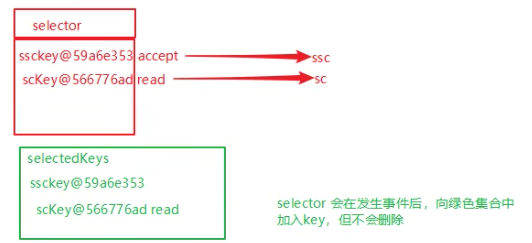
不处理边界出现的问题
将缓冲区的大小设置为4个字节,发送2个汉字(你好),通过decode解码并打印时,会出现乱码
try {// 拿到触发事件的 channelSocketChannel channel = (SocketChannel) key.channel();ByteBuffer buffer = ByteBuffer.allocate(4);// 如果是客户端正常断开,会返回 -1;如果是正常情况,会返回读取的字节数int read = channel.read(buffer);if (read == -1) {key.channel();} else {buffer.flip();// 打印客户端发送的数据System.out.println(Charset.defaultCharset().decode(buffer));}// 处理完毕后,要记得从迭代器中删除当前的 key,防止重复处理iter.remove();} catch (IOException e) {e.printStackTrace();// 如果是客户端异常断开了,需要将key取消(从 selector 的 keys 中真正删除 key)key.cancel();}
10:51:27 [DEBUG] [main] c.i.n.c4.Server - key: sun.nio.ch.SelectionKeyImpl@29ba4338
你�
10:51:27 [DEBUG] [main] c.i.n.c4.Server - selected ready counts: 1
10:51:27 [DEBUG] [main] c.i.n.c4.Server - key: sun.nio.ch.SelectionKeyImpl@29ba4338
��
这是因为在 UTF-8 字符集下,1个汉字占用3个字节,此时缓冲区大小为4个字节,一次读事件无法处理完通道中的所有数据,所以一共会触发两次读事件。这就导致 你好 的 好 字被拆分为了前半部分和后半部分发送,解码时就会出现问题。
处理消息边界
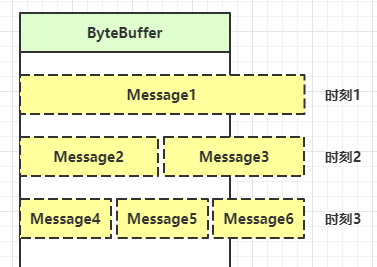
- 一种思路是固定消息长度,数据包大小一样,服务器按预定长度读取,缺点是浪费带宽
- 另一种思路是按分隔符拆分,缺点是效率低
- TLV 格式,即 Type 类型、Length 长度、Value 数据,类型和长度已知的情况下,就可以方便获取消息大小,分配合适的 buffer,缺点是 buffer 需要提前分配,如果内容过大,则影响 server 吞吐量
- Http 1.1 是 TLV 格式
- Http 2.0 是 LTV 格式
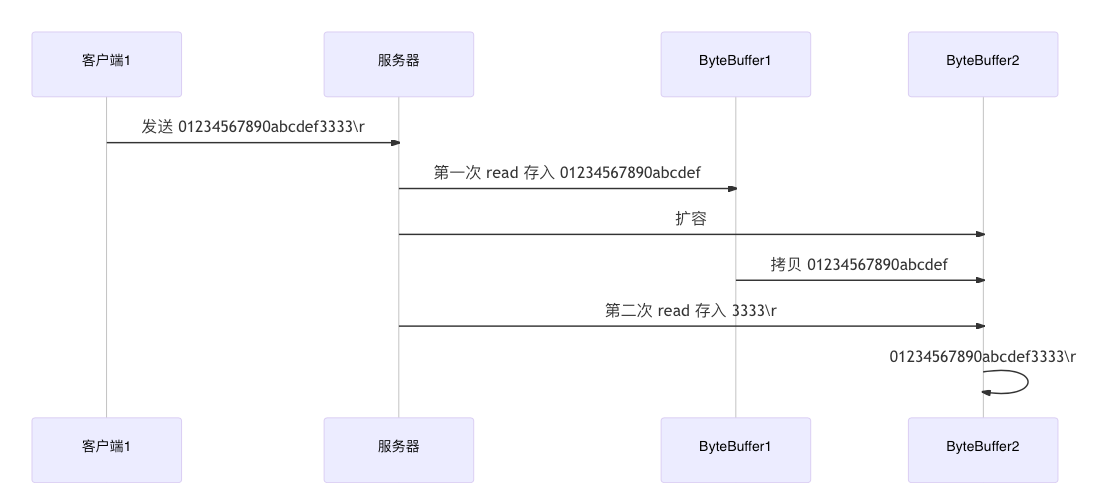
服务端
/*** 服务端*/
@Slf4j
public class Server {private static void split(ByteBuffer source) {// 切换到读模式source.flip();for (int i = 0; i < source.limit(); i++) {// 找到一条完整消息if (source.get(i) == '\n') {int length = i + 1 - source.position();// 把这条完整消息存入新的 ByteBufferByteBuffer target = ByteBuffer.allocate(length);// 从 source 读,向 target 写for (int j = 0; j < length; j++) {target.put(source.get());}debugAll(target);}}// 调用 compact 方法之后,position 的位置就等于往前压缩的字节数,limit 等于 capacitysource.compact();}public static void main(String[] args) throws IOException {// 1、创建 selector,管理多个 channelSelector selector = Selector.open();// 创建选择器ServerSocketChannel ssc = ServerSocketChannel.open();// 绑定监听端口ssc.bind(new InetSocketAddress(8080));// 通道必须设置为非阻塞模式ssc.configureBlocking(false);// 2、建立 selector 和 channel 之间的联系(注册)// SelectionKey 就是将来事件发生后,通过它可以知道是和哪个 channel 发生的事件SelectionKey sscKey = ssc.register(selector, 0, null);// 当前 sscKey 只关注 accept 事件sscKey.interestOps(SelectionKey.OP_ACCEPT);log.debug("register key: {}", sscKey);while (true) {// 3、select 方法,如果没有事件发生,那么线程阻塞;如果有事件,线程才会恢复运行。从而避免了CPU空转// select 方法在事件未处理时,它不会阻塞;如果事件已经处理,它才会阻塞int ready = selector.select();log.debug("selected ready counts: {}", ready);// 4、处理事件,selectedKeys 内部包含了所有发生的事件Set<SelectionKey> selectionKeys = selector.selectedKeys();// 使用迭代器遍历事件Iterator<SelectionKey> iter = selectionKeys.iterator();while (iter.hasNext()) {SelectionKey key = iter.next();log.debug("key: {}", key);// 5、判断事件的类型if (key.isAcceptable()) { // 如果是 accept 事件// 获取key对应的channelServerSocketChannel channel = (ServerSocketChannel) key.channel();log.debug("before accepting...");/*** 事件发生后要么处理,要么取消,不能置之不理* accept 事件只会触发一次,如果不取消,下次 select 的时候,这个事件还会在 selectedKeys 中* 获取连接*/SocketChannel sc = channel.accept();log.debug("after accepting...");// 设置非阻塞模式sc.configureBlocking(false);// 将连接的通道注册到 selector 上ByteBuffer buffer = ByteBuffer.allocate(16);// 将 buffer 作为附件关联到 SelectionKey 上SelectionKey scKey = sc.register(selector, 0, buffer);// 当前 scKey 只关注 read 事件scKey.interestOps(SelectionKey.OP_READ);log.debug("{}", sc);// 处理完毕后,要记得从迭代器中删除当前的 key,防止重复处理iter.remove();} else if (key.isReadable()) { // 如果是 read 事件try {// 拿到触发事件的 channelSocketChannel channel = (SocketChannel) key.channel();// 获取 SelectionKey 关联的附件(ByteBuffer)ByteBuffer buffer = (ByteBuffer) key.attachment();// 如果是客户端正常断开,会返回 -1;如果是正常情况,会返回读取的字节数int read = channel.read(buffer);if (read == -1) {key.channel();} else {split(buffer);if (buffer.position() == buffer.limit()) {// 如果 buffer 满了,将 buffer 扩容ByteBuffer newBuffer = ByteBuffer.allocate(buffer.capacity() * 2);// 旧的 buffer 需要切换成读模式buffer.flip();// 将 buffer 中的数据,转移到 newBuffer 中newBuffer.put(buffer);// 将新的 buffer 作为附件关联到 key 上key.attach(newBuffer);}}// 处理完毕后,要记得从迭代器中删除当前的 key,防止重复处理iter.remove();} catch (IOException e) {e.printStackTrace();// 如果是客户端异常断开了,需要将key取消(从 selector 的 keys 中真正删除 key)key.cancel();}}}}}}
客户端
/*** 客户端*/
public class Client {public static void main(String[] args) throws IOException {// 创建一个客户端SocketChannel sc = SocketChannel.open();// 链接到服务器sc.connect(new InetSocketAddress("localhost", 8080));SocketAddress address = sc.getLocalAddress();// sc.write(Charset.defaultCharset().encode("hello\nworld\n"));sc.write(Charset.defaultCharset().encode("0123456789abcdef3333\n"));System.in.read();}}
ByteBuffer 大小分配
- 每个 channel 都需要记录可能被切分的消息,因为 ByteBuffer 不能被多个 channel 共同使用,因此需要为每个 channel 维护一个独立的 ByteBuffer
- ByteBuffer 不能太大,比如一个 ByteBuffer 1Mb 的话,要支持百万连接就要 1Tb 内存,因此需要设计大小可变的 ByteBuffer
- 一种思路是首先分配一个较小的 buffer,例如 4k,如果发现数据不够,再分配 8k 的 buffer,将 4k buffer 内容拷贝至 8k buffer,优点是消息连续容易处理,缺点是数据拷贝耗费性能,参考实现 http://tutorials.jenkov.com/java-performance/resizable-array.html
- 另一种思路是用多个数组组成 buffer,一个数组不够,把多出来的内容写入新的数组,与前面的区别是消息存储不连续解析复杂,优点是避免了拷贝引起的性能损耗
4.5、处理 write 事件
服务端
public class WriteServer {public static void main(String[] args) throws IOException {ServerSocketChannel ssc = ServerSocketChannel.open();// 设置非阻塞模式ssc.configureBlocking(false);Selector selector = Selector.open();ssc.register(selector, SelectionKey.OP_ACCEPT);ssc.bind(new InetSocketAddress(8080));while (true) {selector.select();Iterator<SelectionKey> iter = selector.selectedKeys().iterator();while (iter.hasNext()) {SelectionKey key = iter.next();// accept 事件if (key.isAcceptable()) {// 拿到 ServerSocketChannelSocketChannel sc = ssc.accept();// 设置非阻塞模式sc.configureBlocking(false);SelectionKey scKey = sc.register(selector, 0, null);// 1、向客户端发送大量数据StringBuilder sb = new StringBuilder();for (int i = 0; i < 5000000; i++) {sb.append("a");}ByteBuffer buffer = Charset.defaultCharset().encode(sb.toString());// 2、返回值代表实际写入的字节数int write = sc.write(buffer);System.out.println(write);// 3、判断是否还有剩余的数据if (buffer.hasRemaining()) {// 4、关注可写事件(在原来的基础上,再加上可写事件)scKey.interestOps(scKey.interestOps() + SelectionKey.OP_WRITE);// 5、把剩余内容的 buffer 挂到 scKey 上(也就是指未写完的内容)scKey.attach(buffer);}// 事件处理掉了,就需要移除了iter.remove();} else if (key.isWritable()) { // 可写事件// 把剩余内容的 buffer 取出来ByteBuffer buffer = (ByteBuffer) key.attachment();SocketChannel sc = (SocketChannel) key.channel();int write = sc.write(buffer);System.out.println(write);// 6、清理操作if (!buffer.hasRemaining()) { // 写完了// 6.1、需要清除 bufferkey.attach(null);// 6.2、不需要关注可写事件了key.interestOps(key.interestOps() - SelectionKey.OP_WRITE);}// 事件处理掉了,就需要移除了iter.remove();}}}}
}
客户端
public class WriteClient {public static void main(String[] args) throws IOException {SocketChannel sc = SocketChannel.open();sc.connect(new InetSocketAddress("localhost", 8080));// 3. 接收数据int count = 0;while (true) {ByteBuffer buffer = ByteBuffer.allocate(1024 * 1024);// 累加读取的字节数count += sc.read(buffer);System.out.println(count);// 每读一次,清空一次缓冲区buffer.clear();}}}
write 为何要取消
只要向 channel 发送数据时,socket 缓冲可写,这个事件就会频繁触发,因此应当只在 socket 缓冲区写不下时再关注可写事件,数据写完之后再取消关注。
4.6、更进一步
利用多线程优化
现在都是多核 cpu,设计时要充分考虑别让 cpu 的力量被白白浪费
前面的代码只有一个选择器,没有充分利用多核 cpu,如何改进呢?
分两组选择器
- 单线程配一个选择器,专门处理 accept 事件
- 创建 cpu 核心数的线程,每个线程配一个选择器,轮流处理 read 事件
每个 selector 对应一个线程,一个 selector 可以管理多个 SocketChannel 上发生的事件
Boss 只关心 Accept 事件,也就是只负责建立连接(有一个 Boss 就够了)
Worker 关心 read、write 事件,也就是只负责数据的读写,且 Worker 数量不能太多,最好和 cpu 核心数一样
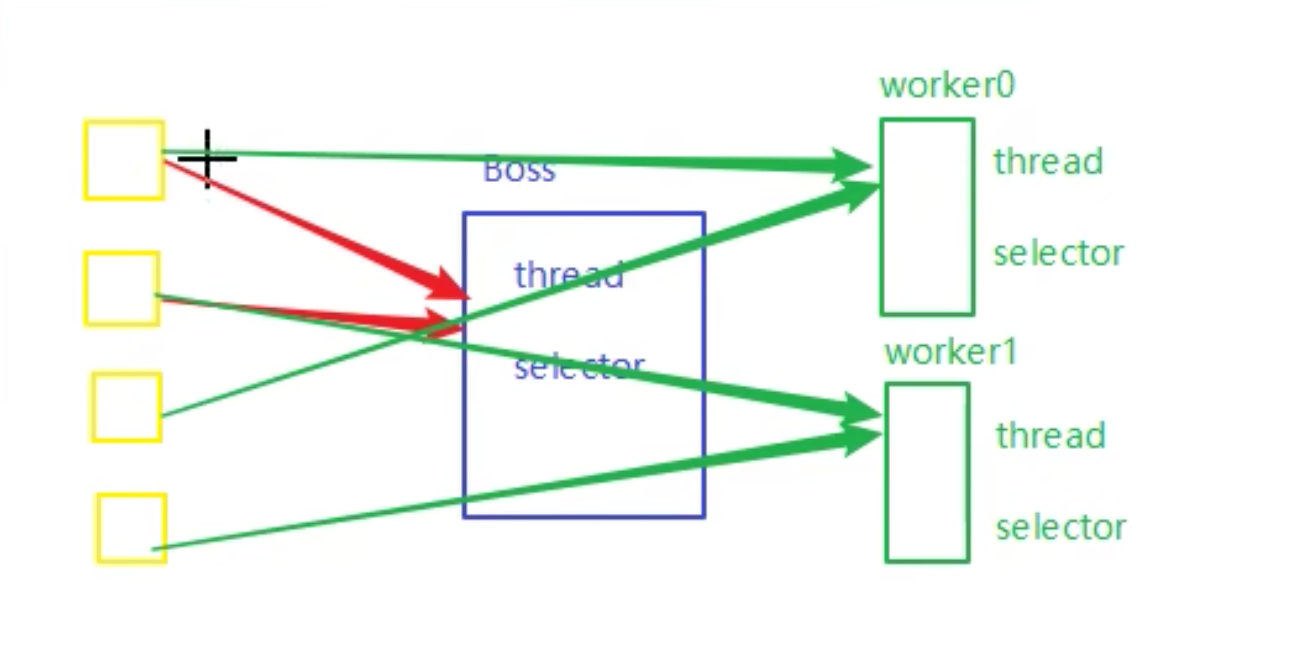
服务端
注意:socketChannel.register(this.selector, SelectionKey.OP_READ, null); 只有在 selector.select(); 阻塞住的时候,它才会注册失败(也就是事件注册不上)
@Slf4j
public class MultiThreadServer {public static void main(String[] args) throws IOException {// 修改主线程的名字叫做 bossThread.currentThread().setName("boss");ServerSocketChannel ssc = ServerSocketChannel.open();ssc.configureBlocking(false);// 创建一个 Boss selectorSelector boss = Selector.open();SelectionKey bossKey = ssc.register(boss, 0, null);bossKey.interestOps(SelectionKey.OP_ACCEPT);ssc.bind(new InetSocketAddress(8080));// 创建固定数量的 worker 并初始化Worker worker = new Worker("worker-0");while (true) {// 监听 boss selector 上的事件boss.select();Iterator<SelectionKey> iter = boss.selectedKeys().iterator();while (iter.hasNext()) {SelectionKey key = iter.next();iter.remove();// boss selector 只关心 accept 事件if (key.isAcceptable()) {SocketChannel sc = ssc.accept();sc.configureBlocking(false);log.debug("connected...{}", sc.getRemoteAddress());// SocketChannel 关联到 worker selectorlog.debug("before register...{}", sc.getRemoteAddress());worker.register(sc); // 这行代码是被 boss 线程所调用,初始化 selector,启动 worker-0 线程log.debug("after register...{}", sc.getRemoteAddress());}}}}/*** 每个worker都有一个对应的selector和thread* 一个worker可以对应多个socketChannel*/static class Worker implements Runnable {private Thread thread;private Selector selector;// worker 线程名字private String name;private volatile boolean start = false; // 还未初始化// 线程安全的队列private ConcurrentLinkedQueue<Runnable> queue = new ConcurrentLinkedQueue<>();public Worker(String name) {this.name = name;}// 初始化线程和 selectorpublic void register(SocketChannel socketChannel) throws IOException {if (!start) {thread = new Thread(this, name);// 启动线程thread.start();// 初始化selectorselector = Selector.open();start = true;}/*** 向队列添加任务,但是这个任务并没有被立刻执行* 注意:这里是boss线程往队列里面添加任务,但是没有执行这个任务,后面会在worker线程里面执行*/queue.add(() -> {try {// 将socketChannel注册到selector上,并且关注读事件socketChannel.register(this.selector, SelectionKey.OP_READ, null);} catch (ClosedChannelException e) {e.printStackTrace();}});// 唤醒selector,让selector不再阻塞selector.wakeup();}/*** 线程要执行的run方法* worker 只负责监测读写事件*/@Overridepublic void run() {while (true) {try {selector.select(); // worker-0Runnable task = queue.poll();if (task != null) {task.run(); // 这里执行的是队列里面的任务}// 获取当前selector监听到的所有事件(也就是socketChannel上的读写事件)Iterator<SelectionKey> iter = selector.selectedKeys().iterator();while (iter.hasNext()) {SelectionKey key = iter.next();// 可读事件if (key.isReadable()) {ByteBuffer buffer = ByteBuffer.allocate(16);SocketChannel channel = (SocketChannel) key.channel();log.debug("read...{}", channel.getRemoteAddress());channel.read(buffer);// 切换到读模式buffer.flip();debugAll(buffer);}// 执行完毕,移除当前事件iter.remove();}} catch (IOException e) {e.printStackTrace();}}}}
}
还有另一种优化方式(不过第一种方式更好一点):
// 初始化线程和 selectorpublic void register(SocketChannel socketChannel) throws IOException {if (!start) {thread = new Thread(this, name);// 启动线程thread.start();// 初始化selectorselector = Selector.open();start = true;}// 唤醒selector,让selector不再阻塞selector.wakeup();// 将socketChannel注册到selector上,并且关注读事件socketChannel.register(this.selector, SelectionKey.OP_READ, null);}
客户端
public class TestClient {public static void main(String[] args) throws IOException {SocketChannel sc = SocketChannel.open();sc.connect(new InetSocketAddress("localhost", 8080));sc.write(Charset.defaultCharset().encode("1234567890abcdef"));System.in.read();}}
如何拿到 CPU 个数
- Runtime.getRuntime( ).availableProcessors( ) 如果工作在 docker 容器下,因为容器不是物理隔离的,会拿到物理 cpu 个数,而不是容器申请时的个数(jdk8 建议手动设置核心数比较好)
- 这个问题直到 jdk 10 才修复,使用 jvm 参数 UseContainerSupport 配置, 默认开启
多个 worker 的情况
@Slf4j
public class MultiThreadServer {public static void main(String[] args) throws IOException {// 修改主线程的名字叫做 bossThread.currentThread().setName("boss");ServerSocketChannel ssc = ServerSocketChannel.open();ssc.configureBlocking(false);// 创建一个 Boss selectorSelector boss = Selector.open();SelectionKey bossKey = ssc.register(boss, 0, null);bossKey.interestOps(SelectionKey.OP_ACCEPT);ssc.bind(new InetSocketAddress(8080));// 创建固定数量的 worker,并初始化Worker[] workers = new Worker[Runtime.getRuntime().availableProcessors()]; // 获取当前机器的核数for (int i = 0; i < workers.length; i++) {workers[i] = new Worker("worker-" + i);}// 计数器AtomicInteger index = new AtomicInteger();while (true) {// 监听 boss selector 上的事件boss.select();Iterator<SelectionKey> iter = boss.selectedKeys().iterator();while (iter.hasNext()) {SelectionKey key = iter.next();iter.remove();// boss selector 只关心 accept 事件if (key.isAcceptable()) {SocketChannel sc = ssc.accept();sc.configureBlocking(false);log.debug("connected...{}", sc.getRemoteAddress());// SocketChannel 关联到 worker selectorlog.debug("before register...{}", sc.getRemoteAddress());// round robin 轮询workers[index.getAndIncrement() % workers.length].register(sc); // 这行代码是被 boss 线程所调用,初始化 selector,启动 worker-0 线程log.debug("after register...{}", sc.getRemoteAddress());}}}}/*** 每个worker都有一个对应的selector和thread* 一个worker可以对应多个socketChannel*/static class Worker implements Runnable {private Thread thread;private Selector selector;// worker 线程名字private String name;private volatile boolean start = false; // 还未初始化// 线程安全的队列private ConcurrentLinkedQueue<Runnable> queue = new ConcurrentLinkedQueue<>();public Worker(String name) {this.name = name;}// 初始化线程和 selectorpublic void register(SocketChannel socketChannel) throws IOException {if (!start) {thread = new Thread(this, name);// 启动线程thread.start();// 初始化selectorselector = Selector.open();start = true;}/*** 向队列添加任务,但是这个任务并没有被立刻执行* 注意:这里是boss线程往队列里面添加任务,但是没有执行这个任务,后面会在worker线程里面执行*/queue.add(() -> {try {// 将socketChannel注册到selector上,并且关注读事件socketChannel.register(this.selector, SelectionKey.OP_READ, null);} catch (ClosedChannelException e) {e.printStackTrace();}});// 唤醒selector,让selector不再阻塞selector.wakeup();}/*** 线程要执行的run方法* worker 只负责监测读写事件*/@Overridepublic void run() {while (true) {try {selector.select(); // worker-0Runnable task = queue.poll();if (task != null) {task.run(); // 这里执行的是队列里面的任务}// 获取当前selector监听到的所有事件(也就是socketChannel上的读写事件)Iterator<SelectionKey> iter = selector.selectedKeys().iterator();while (iter.hasNext()) {SelectionKey key = iter.next();// 可读事件if (key.isReadable()) {ByteBuffer buffer = ByteBuffer.allocate(16);SocketChannel channel = (SocketChannel) key.channel();log.debug("read...{}", channel.getRemoteAddress());channel.read(buffer);// 切换到读模式buffer.flip();debugAll(buffer);}// 执行完毕,移除当前事件iter.remove();}} catch (IOException e) {e.printStackTrace();}}}}
}
5、NIO VS BIO
5.1、stream vs channel
- stream 不会自动缓冲数据,channel 会利用系统提供的发送缓冲区、接收缓冲区(更为底层)
- stream 仅支持阻塞 API,channel 同时支持阻塞、非阻塞 API,网络 channel 可配合 selector 实现多路复用
- 二者均为全双工,即读写可以同时进行
5.2、IO 模型
同步阻塞、同步非阻塞、同步多路复用、异步阻塞(没有此情况)、异步非阻塞
- 同步:线程自己去获取结果(一个线程)
- 异步:线程自己不去获取结果,而是由其它线程送结果(至少两个线程)
当调用一次 channel.read 或 stream.read 后,会切换至操作系统内核态来完成真正数据读取,而读取又分为两个阶段,分别为:
- 等待数据阶段
- 复制数据阶段
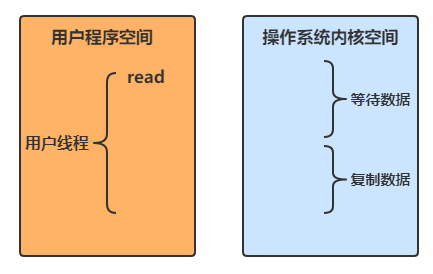
阻塞 IO
用户线程进行read操作时,需要等待操作系统执行实际的read操作,此期间用户线程是被阻塞的,无法执行其他操作
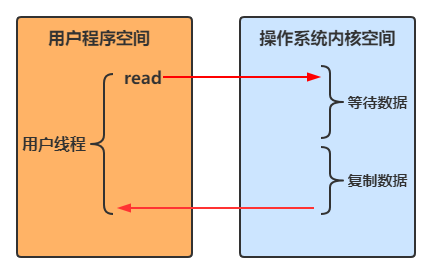
非阻塞 IO
- 用户线程在一个循环中一直调用 read 方法,若内核空间中还没有数据可读,立即返回
- 只是在等待阶段非阻塞
- 用户线程发现内核空间中有数据后,等待内核空间执行复制数据,待复制结束后返回结果
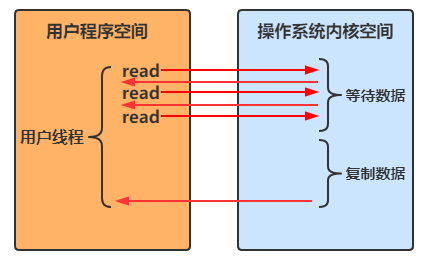
多路复用
Java中通过 Selector 实现多路复用
- 当没有事件是,调用select方法会被阻塞住
- 一旦有一个或多个事件发生后,就会处理对应的事件,从而实现多路复用
多路复用与阻塞IO的区别
- 阻塞IO模式下,若线程因 accept 事件被阻塞,发生 read 事件后,仍需等待 accept 事件执行完成后,才能去处理 read 事件
- 多路复用模式下,一个事件发生后,若另一个事件处于阻塞状态,不会影响该事件的执行
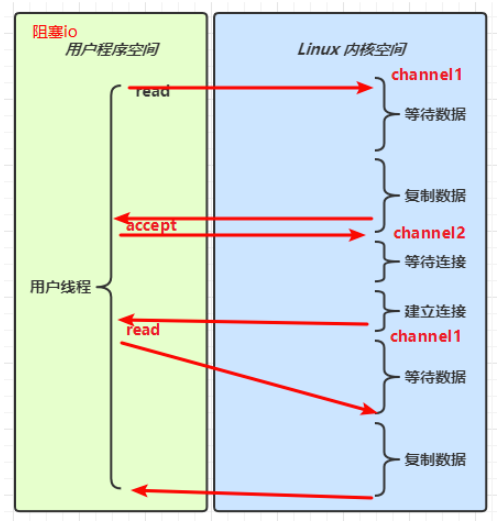
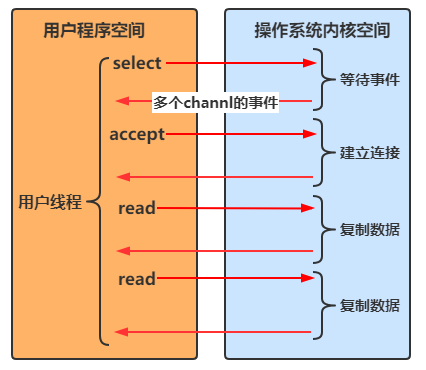
异步 IO
- 线程1调用方法后立刻返回,不会被阻塞也不需要立即获取结果
- 当方法的运行结果出来以后,由线程2将结果返回给线程1
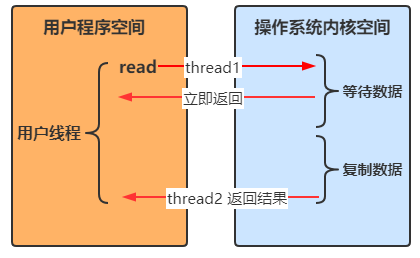
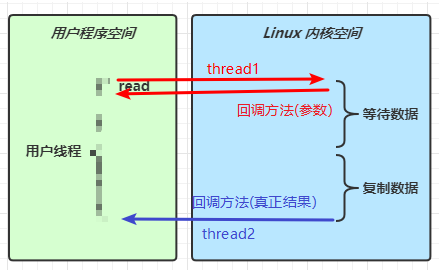
5.3、零拷贝
零拷贝指的是数据无需拷贝到 JVM 内存中,同时具有以下三个优点:
- 更少的用户态与内核态的切换
- 不利用 cpu 计算,减少 cpu 缓存伪共享
- 零拷贝适合小文件传输
传统 IO 问题
传统的 IO 将一个文件通过 socket 写出:
File f = new File("helloword/data.txt");
RandomAccessFile file = new RandomAccessFile(file, "r");byte[] buf = new byte[(int)f.length()];
file.read(buf); // 用户态 -> 内核态Socket socket = ...; // 内核态 -> 用户态
socket.getOutputStream().write(buf); // 用户态 -> 内核态
内部工作流程是这样的:

1、java 本身并不具备 IO 读写能力,因此 read 方法调用后,要从 java 程序的用户态切换至内核态,去调用操作系统(Kernel)的读能力,将数据读入内核缓冲区。这期间用户线程阻塞,操作系统使用 DMA(Direct Memory Access)来实现文件读,其间也不会使用 cpu
DMA 也可以理解为硬件单元,用来解放 cpu 完成文件 IO
2、从内核态切换回用户态,将数据从内核缓冲区读入用户缓冲区(即 byte[] buf),这期间 cpu 会参与拷贝,无法利用 DMA
3、调用 write 方法,这时将数据从用户缓冲区(byte[] buf)写入 socket 缓冲区,cpu 会参与拷贝
4、接下来要向网卡写数据,这项能力 java 又不具备,因此又得从用户态切换至内核态,调用操作系统的写能力,使用 DMA 将 socket 缓冲区的数据写入网卡,不会使用 cpu
可以看到中间环节较多,java 的 IO 实际不是物理设备级别的读写,而是缓存的复制,底层的真正读写是操作系统来完成的
- 用户态与内核态的切换发生了 3 次,这个操作比较重量级
- 数据拷贝了共 4 次
NIO 优化
通过 DirectByteBuf
- ByteBuffer.allocate(10),返回的是 HeapByteBuffer,使用的还是 java 内存
- ByteBuffer.allocateDirect(10) 返回的是 DirectByteBuffer,使用的是操作系统内存
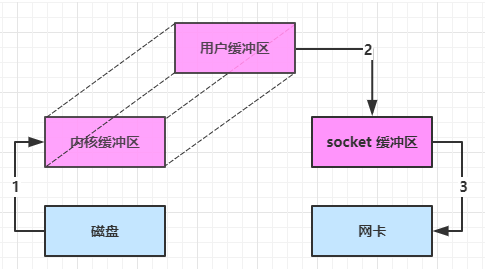
大部分步骤与优化前相同,不再赘述。唯有一点:java 可以使用 DirectByteBuf 将堆外内存映射到 jvm 内存中来直接访问使用
- 这块内存不受 jvm 垃圾回收的影响,因此内存地址固定,有助于 IO 读写
- java 中的 DirectByteBuf 对象仅维护了此内存的虚引用,内存回收分成两步
- DirectByteBuf 对象被垃圾回收,将虚引用加入引用队列
- 通过专门线程访问引用队列,根据虚引用释放堆外内存
- 减少了一次数据拷贝,用户态与内核态的切换次数没有减少
进一步优化(底层采用了 linux 2.1 后提供的 sendFile 方法),java 中对应着两个 channel 调用 transferTo/transferFrom 方法拷贝数据
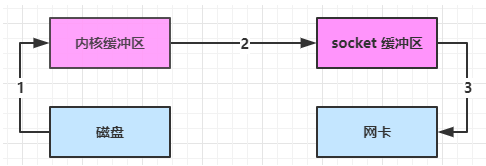
- java 调用 transferTo 方法后,要从 java 程序的用户态切换至内核态,使用 DMA将数据读入内核缓冲区,不会使用 cpu
- 数据从内核缓冲区传输到 socket 缓冲区,cpu 会参与拷贝
- 最后使用 DMA 将 socket 缓冲区的数据写入网卡,不会使用 cpu
可以看到
- 只发生了一次用户态与内核态的切换
- 数据拷贝了 3 次
进一步优化(linux 2.4)
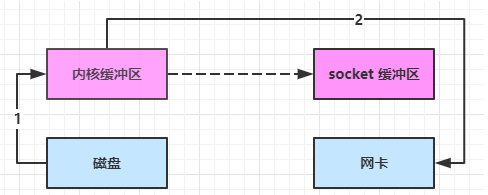
- java 调用 transferTo 方法后,要从 java 程序的用户态切换至内核态,使用 DMA将数据读入内核缓冲区,不会使用 cpu
- 只会将一些 offset 和 length 信息拷入 socket 缓冲区,几乎无消耗
- 使用 DMA 将 内核缓冲区的数据写入网卡,不会使用 cpu
整个过程仅只发生了一次用户态与内核态的切换,数据拷贝了 2 次。所谓的【零拷贝】,并不是真正无拷贝,而是在不会拷贝重复数据到 jvm 内存中,零拷贝的优点有
- 更少的用户态与内核态的切换
- 不利用 cpu 计算,减少 cpu 缓存伪共享
- 零拷贝适合小文件传输
5.4、AIO
AIO 用来解决数据复制阶段的阻塞问题
- 同步意味着,在进行读写操作时,线程需要等待结果,还是相当于闲置
- 异步意味着,在进行读写操作时,线程不必等待结果,而是将来由操作系统来通过回调方式由另外的线程来获得结果
异步模型需要底层操作系统(Kernel)提供支持
- Windows 系统通过 IOCP 实现了真正的异步 IO
- Linux 系统异步 IO 在 2.6 版本引入,但其底层实现还是用多路复用模拟了异步 IO,性能没有优势
文件 AIO
先来看看 AsynchronousFileChannel
@Slf4j
public class AioFileChannel {public static void main(String[] args) throws IOException {try (AsynchronousFileChannel channel = AsynchronousFileChannel.open(Paths.get("data.txt"), StandardOpenOption.READ)) {ByteBuffer buffer = ByteBuffer.allocate(16);log.debug("read begin...");/*** 参数1 ByteBuffer* 参数2 读取的起始位置* 参数3 附件* 参数4 回调对象 CompletionHandler*/channel.read(buffer, 0, buffer, new CompletionHandler<Integer, ByteBuffer>() {/*** read 成功,会调用该方法*/@Overridepublic void completed(Integer result, ByteBuffer attachment) {log.debug("read completed...{}", result);attachment.flip();debugAll(attachment);}/*** read 失败,会调用该方法*/@Overridepublic void failed(Throwable exc, ByteBuffer attachment) {exc.printStackTrace();}});log.debug("read end...");} catch (IOException e) {e.printStackTrace();}System.in.read();}}


)

 消息中间件 NOTE)







)



)


